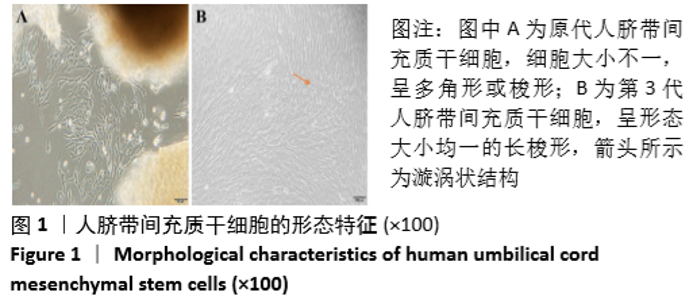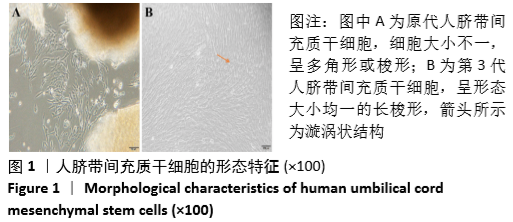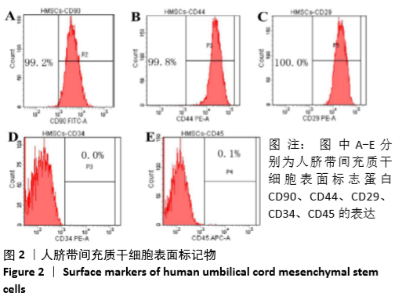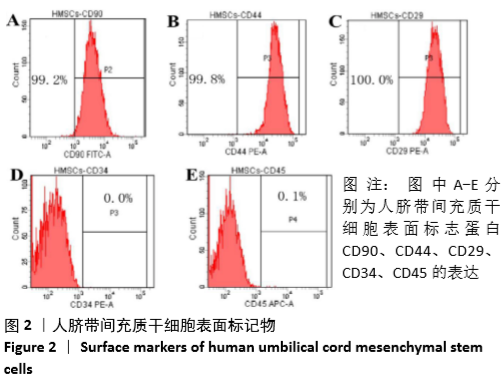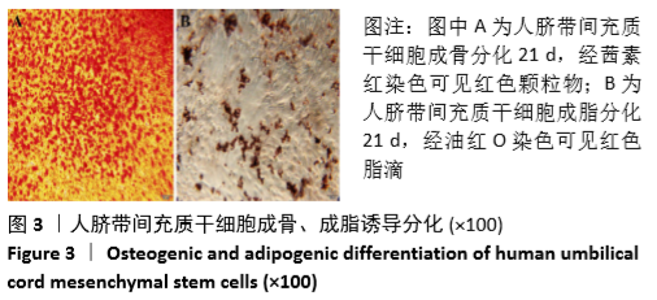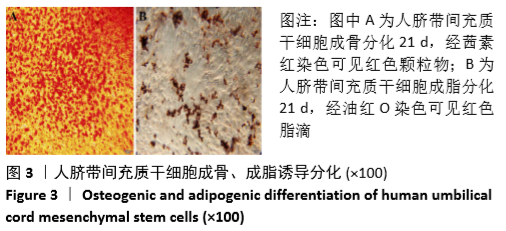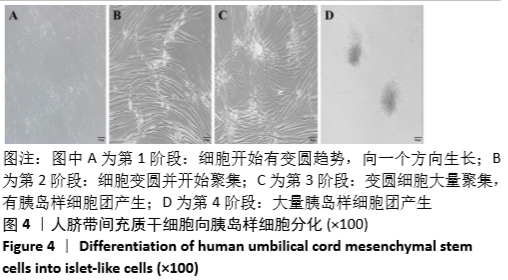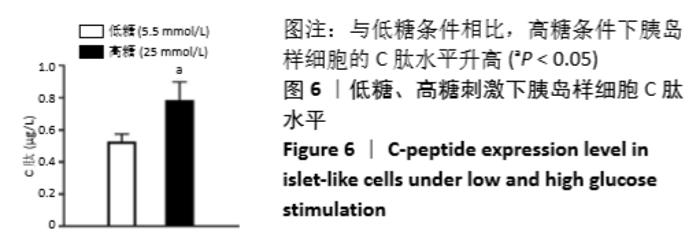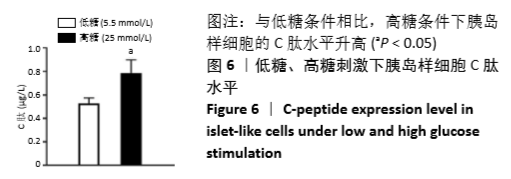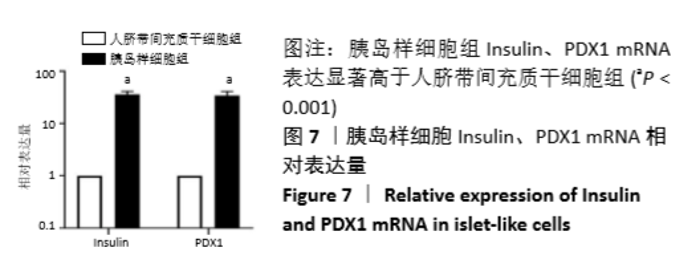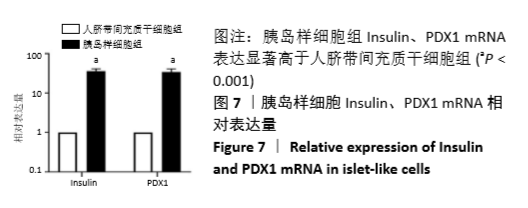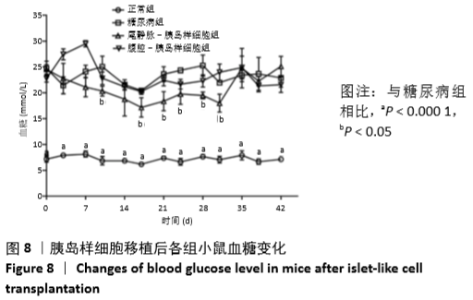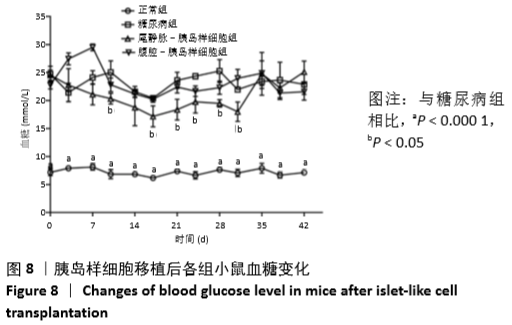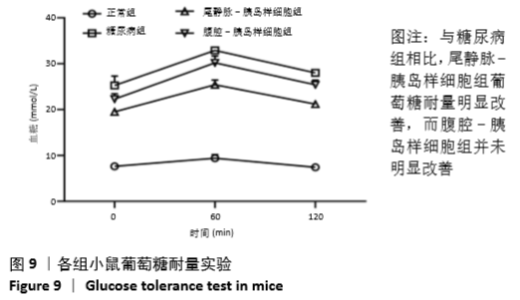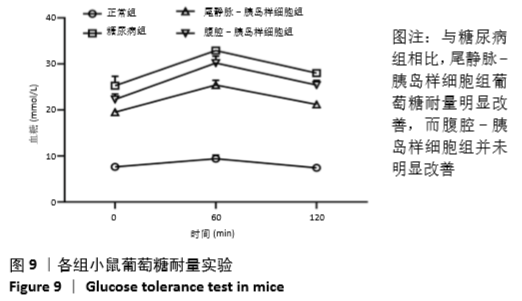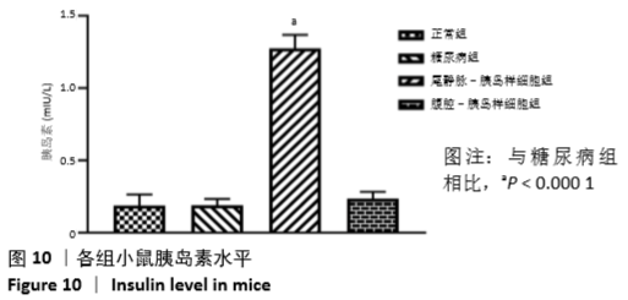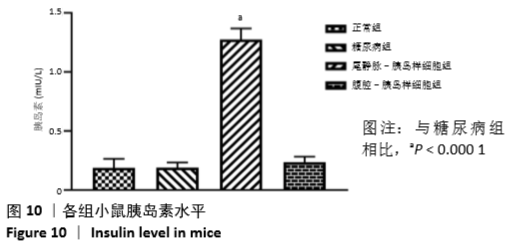Chinese Journal of Tissue Engineering Research ›› 2021, Vol. 25 ›› Issue (1): 78-83.doi: 10.3969/j.issn.2095-4344.2144
Previous Articles Next Articles
Transplantation of islet-like cells induced by human umbilical cord mesenchymal stem cells via different ways for the treatment of type 1 diabetic mice
Guo Xuan1, Xie Jun1, Suo Jinrong2, Li Yingrui1, Huang Lei1, Ma Munan1, Li Jingjing3, Fu Songtao1, 2, 3
- 1Department of Biochemistry and Molecular Biology, School of Basic Medicine, Shanxi Medical University, Taiyuan 030001, Shanxi Province, China; 2Shanxi Binda Stem Cell Technology Co., Ltd., Taiyuan 030001, Shanxi Province, China; 3Shanxi Provincial Biomedical Health Graduate Education Innovation Center, Taiyuan 030001, Shanxi Province, China
-
Received:2020-01-04Revised:2020-01-10Accepted:2020-02-19Online:2021-01-08Published:2020-11-19 -
Contact:Fu Songtao, Master, Professor, Department of Biochemistry and Molecular Biology, School of Basic Medicine, Shanxi Medical University, Taiyuan 030001, Shanxi Province, China; Shanxi Binda Stem Cell Technology Co., Ltd., Taiyuan 030001, Shanxi Province, China; Shanxi Provincial Biomedical Health Graduate Education Innovation Center, Taiyuan 030001, Shanxi Province, China -
About author:Guo Xuan, Master, Department of Biochemistry and Molecular Biology, School of Basic Medicine, Shanxi Medical University, Taiyuan 030001, Shanxi Province, China -
Supported by:the Fund for Shanxi “1331 Project” Key Subject Construction; The International Scientific and Technological Cooperative Foundation of Shanxi Province, No. 201703d421022; Key R&D Program of Shanxi Province (International Cooperation), No. 201903D421023
CLC Number:
Cite this article
Guo Xuan, Xie Jun, Suo Jinrong, Li Yingrui, Huang Lei, Ma Munan, Li Jingjing, Fu Songtao. Transplantation of islet-like cells induced by human umbilical cord mesenchymal stem cells via different ways for the treatment of type 1 diabetic mice[J]. Chinese Journal of Tissue Engineering Research, 2021, 25(1): 78-83.
share this article
Add to citation manager EndNote|Reference Manager|ProCite|BibTeX|RefWorks
| [1] VERES A, FAUST AL, BUSHNELL HL, et al. Charting cellular identity during human in vitro β-cell differentiation. Nature. 2019;569(7756): 368-373. [2] RUSS HA, PARENT AV, RINGLER JJ, et al. Controlled induction of human pancreatic progenitors produces functional beta-like cells in vitro. EMBO J. 2015;34(13):1759-1772. [3] AMERICAN DIABETES ASSOCIATION. Economic costs of diabetes in the U.S. in 2012. Diabetes Care. 2013;36(4):1033-1046. [4] FRYER BH, REZANIA A, ZIMMERMAN MC. Generating β-cells in vitro: progress towards a Holy Grail. Curr Opin Endocrinol Diabetes Obes. 2013;20(2):112-117. [5] STEPHENS CH, ORR KS, ACTON AJ, et al. In situ type I oligomeric collagen macroencapsulation promotes islet longevity and function in vitro and in vivo. Am J Physiol Endocrinol Metab. 2018;315(4): E650-E661. [6] LENNON DP, EDMISON JM, CAPLAN AI. Cultivation of rat marrow-derived mesenchymal stem cells in reduced oxygen tension: effects on in vitro and in vivo osteochondrogenesis. J Cell Physiol. 2001;187(3):345-355. [7] PITTENGER MF, MACKAY AM, BECK SC, et al. Multilineage potential of adult human mesenchymal stem cells. Science. 1999;284(5411): 143-147. [8] HAKUNO D, FUKUDA K, MAKINO S, et al. Bone marrow-derived regenerated cardiomyocytes (CMG Cells) express functional adrenergic and muscarinic receptors. Circulation. 2002;105(3): 380-386. [9] JIANG J, AU M, LU K, et al. Generation of insulin-producing islet-like clusters from human embryonic stem cells. Stem Cells. 2007;25(8): 1940-1953. [10] WANG H, QIU X, NI P, et al. Immunological characteristics of human umbilical cord mesenchymal stem cells and the therapeutic effects of their transplantion on hyperglycemia in diabetic rats. Int J Mol Med. 2014;33(2):263-270. [11] YU S, CHENG Y, ZHANG L, et al. Treatment with adipose tissue-derived mesenchymal stem cells exerts anti-diabetic effects, improves long-term complications, and attenuates inflammation in type 2 diabetic rats. Stem Cell Res Ther. 2019;10(1):333. [12] TSAI PJ, WANG HS, LIN GJ, et al. Undifferentiated Wharton’s Jelly Mesenchymal Stem Cell Transplantation Induces Insulin-Producing Cell Differentiation and Suppression of T-Cell-Mediated Autoimmunity in Nonobese Diabetic Mice. Cell Transplant. 2015;24(8):1555-1570. [13] HU J, WANG Y, WANG F, et al. Effect and mechanisms of human Wharton’s jelly-derived mesenchymal stem cells on type 1 diabetes in NOD model. Endocrine. 2015;48(1):124-134. [14] CHAO KC, CHAO KF, FU YS, et al. Islet-like clusters derived from mesenchymal stem cells in Wharton’s Jelly of the human umbilical cord for transplantation to control type 1 diabetes. PLoS One. 2008; 3(1):e1451. [15] 山霞,崔晓兰,时瀚,等.人脐带间充质干细胞诱导分化不同阶段的胰岛样细胞移植治疗糖尿病[J].中国组织工程研究, 2017, 21(29):4703-4708. [16] YU YB, BIAN JM, GU DH. Transplantation of insulin-producing cells to treat diabetic rats after 90% pancreatectomy. World J Gastroenterol. 2015;21(21):6582-6590. [17] PRABAKAR KR, DOMÍNGUEZ-BENDALA J, MOLANO RD, et al. Generation of glucose-responsive, insulin-producing cells from human umbilical cord blood-derived mesenchymal stem cells. Cell Transplant. 2012;21(6):1321-1339. [18] 李兰兰,李宁,杨晓菲,等.人脐带间充质干细胞分化为胰岛素分泌细胞的免疫原性变化[J].中国组织工程研究,2018,22(13): 2045-2050. [19] EL-TANTAWY WH, HALEEM EN. Therapeutic effects of stem cell on hyperglycemia, hyperlipidemia, and oxidative stress in alloxan-treated rats. Mol Cell Biochem. 2014;391(1-2):193-200. [20] LI B, CHENG Y, YU S, et al. Human Umbilical Cord-Derived Mesenchymal Stem Cell Therapy Ameliorates Nonalcoholic Fatty Liver Disease in Obese Type 2 Diabetic Mice. Stem Cells Int. 2019;2019: 8628027. [21] DAVIES JE, WALKER JT, KEATING A. Concise Review: Wharton’s Jelly: The Rich, but Enigmatic, Source of Mesenchymal Stromal Cells. Stem Cells Transl Med. 2017;6(7):1620-1630. [22] 杨文英.中国糖尿病的流行特点及变化趋势[J].中国科学:生命科学, 2018, 48(8):812-819. [23] TAN K, ZHENG K, LI D, et al. Impact of adipose tissue or umbilical cord derived mesenchymal stem cells on the immunogenicity of human cord blood derived endothelial progenitor cells. PLoS One. 2017;12(5): e0178624. [24] DING DC, CHANG YH, SHYU WC, et al. Human umbilical cord mesenchymal stem cells: a new era for stem cell therapy. Cell Transplant. 2015;24(3):339-347. [25] CORSELLO T, AMICO G, CORRAO S, et al. Wharton’s Jelly Mesenchymal Stromal Cells from Human Umbilical Cord: a Close-up on Immunomodulatory Molecules Featured In Situ and In Vitro. Stem Cell Rev Rep. 2019;15(6):900-918. [26] BARCZEWSKA M, GRUDNIAK M, MAKSYMOWICZ S, et al. Safety of intrathecal injection of Wharton’s jelly-derived mesenchymal stem cells in amyotrophic lateral sclerosis therapy. Neural Regen Res. 2019; 14(2):313-318. [27] ROUSHANDEH AM, BAHADORI M, ROUDKENAR MH. Mesenchymal Stem Cell-based Therapy as a New Horizon for Kidney Injuries. Arch Med Res. 2017;48(2):133-146. [28] LEE HJ, KANG KS, KANG SY, et al. Immunologic properties of differentiated and undifferentiated mesenchymal stem cells derived from umbilical cord blood. J Vet Sci. 2016;17(3):289-297. [29] 杨大威,林和敏,刘广鹏.成骨分化的人脐带血间充质干细胞免疫原性研究[J].中国修复重建外科杂志,2014,28(6):752-757. [30] 刘志刚,张万华,刘霆.腹膜腔细胞的免疫特性及功能研究进展[J].重庆医学,2019,48(14):2467-2470. [31] 郭波,刘佳,崔晓兰,等.人脐带间充质干细胞联合免疫干预治疗1型糖尿病小鼠的实验研究[J].中国组织工程研究, 2019,23(13): 2016-2021. [32] MACLEAN FL, IMS GM, HORNE MK, et al. A Programmed Anti-Inflammatory Nanoscaffold (PAIN) as a 3D Tool to Understand the Brain Injury Response. Adv Mater. 2018;30(50):e1805209. |
| [1] | Wang Jinjun, Deng Zengfa, Liu Kang, He Zhiyong, Yu Xinping, Liang Jianji, Li Chen, Guo Zhouyang. Hemostatic effect and safety of intravenous drip of tranexamic acid combined with topical application of cocktail containing tranexamic acid in total knee arthroplasty [J]. Chinese Journal of Tissue Engineering Research, 2021, 25(9): 1356-1361. |
| [2] | Li Jing, Xie Jianshan, Cui Huilin, Cao Ximei, Yang Yanping, Li Hairong. Expression and localization of diacylglycerol kinase zeta and protein kinase C beta II in mouse back skin with different coat colors [J]. Chinese Journal of Tissue Engineering Research, 2021, 25(8): 1196-1200. |
| [3] | Chen Jiming, Wu Xiaojing, Liu Tianfeng, Chen Haicong, Huang Chengshuo. Effects of silymarin on liver injury and bone metabolism induced by carbon tetrachloride in mice [J]. Chinese Journal of Tissue Engineering Research, 2021, 25(8): 1224-1228. |
| [4] | Wang Zhengdong, Huang Na, Chen Jingxian, Zheng Zuobing, Hu Xinyu, Li Mei, Su Xiao, Su Xuesen, Yan Nan. Inhibitory effects of sodium butyrate on microglial activation and expression of inflammatory factors induced by fluorosis [J]. Chinese Journal of Tissue Engineering Research, 2021, 25(7): 1075-1080. |
| [5] | Li Shanshan, Guo Xiaoxiao, You Ran, Yang Xiufen, Zhao Lu, Chen Xi, Wang Yanling. Photoreceptor cell replacement therapy for retinal degeneration diseases [J]. Chinese Journal of Tissue Engineering Research, 2021, 25(7): 1116-1121. |
| [6] | Wang Feng, Zhou Liyu, Saijilafu, Qi Shibin, Ma Yanxia, Wei Shanwen. CaMKII-Smad1 promotes axonal regeneration of peripheral nerves [J]. Chinese Journal of Tissue Engineering Research, 2021, 25(7): 1064-1068. |
| [7] | Zhang Mi, Wu Saixuan, Dong Ming, Lu Ying, Niu Weidong. Expression of interleukin-24 in a mouse model of periapical periodontitis [J]. Chinese Journal of Tissue Engineering Research, 2021, 25(5): 679-684. |
| [8] | Xie Yang, Zhang Shujiang, Liu Menglan, Luo Ying, Yang Yang, Li Zuoxiao. Mechanism by which rapamycin protects spinal cord neurons in experimental autoimmune encephalomyelitis mice [J]. Chinese Journal of Tissue Engineering Research, 2021, 25(5): 695-700. |
| [9] | Jiang Xin, Qiao Liangwei, Sun Dong, Li Ming, Fang Jun, Qu Qingshan. Expression of long chain non-coding RNA PGM5-AS1 in serum of renal transplant patients and its regulation of human glomerular endothelial cells [J]. Chinese Journal of Tissue Engineering Research, 2021, 25(5): 741-745. |
| [10] | Yang Xin, Jin Zhe, Feng Xu, Lu Bing. The current situation of knowledge and attitudes towards organ, eye tissue, body donation of residents in Shenyang [J]. Chinese Journal of Tissue Engineering Research, 2021, 25(5): 779-784. |
| [11] | Zeng Xianghong, Liang Bowei. A new strategy for the treatment of osteonecrosis of the femoral head [J]. Chinese Journal of Tissue Engineering Research, 2021, 25(3): 431-437. |
| [12] | Gao Shan, Huang Dongjing, Hong Haiman, Jia Jingqiao, Meng Fei. Comparison on the curative effect of human placenta-derived mesenchymal stem cells and induced islet-like cells in gestational diabetes mellitus rats [J]. Chinese Journal of Tissue Engineering Research, 2021, 25(25): 3981-3987. |
| [13] | Ruan Guangping, Yao Xiang, Liu-Gao Miyang, Cai Xuemin, Li Zian, Pang Rongqing, Wang Jinxiang, Pan Xinghua. Umbilical cord mesenchymal stem cell transplantation for traumatic systemic inflammatory response syndrome in tree shrews [J]. Chinese Journal of Tissue Engineering Research, 2021, 25(25): 3994-4000. |
| [14] | Xie Yang, Lü Zhiyu, Zhang Shujiang, Long Ting, Li Zuoxiao. Effects of recombinant adeno-associated virus mediated nerve growth factor gene transfection on oligodendrocyte apoptosis and myelination in experimental autoimmune encephalomyelitis mice [J]. Chinese Journal of Tissue Engineering Research, 2021, 25(23): 3678-3683. |
| [15] | Chen Siqi, Xian Debin, Xu Rongsheng, Qin Zhongjie, Zhang Lei, Xia Delin. Effects of bone marrow mesenchymal stem cells and human umbilical vein endothelial cells combined with hydroxyapatite-tricalcium phosphate scaffolds on early angiogenesis in skull defect repair in rats [J]. Chinese Journal of Tissue Engineering Research, 2021, 25(22): 3458-3465. |
| Viewed | ||||||
|
Full text |
|
|||||
|
Abstract |
|
|||||
